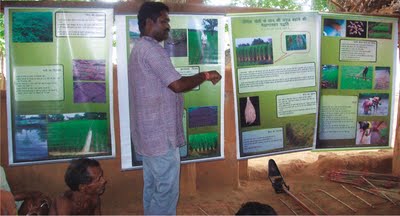 Chhattisgarh is traditionally known as the Rice Bowl of India. Over 20,000 rice varieties have been recorded in the region. These are a result of centuries of rice farming by indigenous communities through selection and adaptation to a variety of soil, water and micro-ecosystems conditions including predators.
Chhattisgarh is traditionally known as the Rice Bowl of India. Over 20,000 rice varieties have been recorded in the region. These are a result of centuries of rice farming by indigenous communities through selection and adaptation to a variety of soil, water and micro-ecosystems conditions including predators.
Today these varieties are being lost with market forces promoting so called high-yielding varieties and synthetic fertilizer and pesticide-based agriculture that focuses only on yield, as well as the general but incorrect perception of traditional varieties as low yielding. There has also been tremendous loss of traditional knowledge associated with traditional agro-ecosystems and production practices.
Dharohar Samiti, a farmer's organization has been working in 10 villages of Kondagaon Tehsil of Bastar district for over 15 years now to promote agro bio-diversity conservation and secure livelihood and nutrition to farmers. The UNDP GEF Small Grants Program (SGP) has supported Dharohoar Samiti in this mission that is conserving over 260 traditional rice varieties along with other minor millets such as raagi, kodo and kutki.
The activities taken up under the SGP projects advocate organic and high yielding farming, based on successful trials and promotion of the System of Rice Intensification (SRI) for traditional varieties and further adaptation of the SRI technique for profitable cultivation of Raagi. Conservation of agro-biodiversity is crucial to the local nutrition security system. The yield of traditional varieties like Basabhog and Asamchudi reaches up to 7 to 8 tonnes per hectare through SRI, which is as good as any High Yielding Variety in the market.
/articles/farmers-groups-conserve-traditional-rice-varieties-bastar-region-chhattisgarh